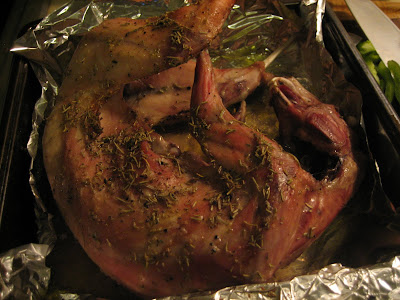
Most of us don't have the money to drop at least a hundred bucks on a truffle (who would think that the fruiting body of an underground mushroom would be so expensive?), but have no fear! You too can taste this highly prized and delectable treat, because you can buy a jar of truffle butter, which is basically butter with bits of truffle mixed into it. A worthwhile purchase, if you ask me because truffles have a very distinctive, strong, earthy flavor and a little of that stuff goes a long way - and man oh man is it delicious. Here I've breaded chicken breasts with oatmeal, then stuffed them with black truffle butter and paired them with pickled red and golden beets and fresh spinach (or try watercress, if you can find it). This is one of my favorite ways to use truffle butter, for sure, although I also like to use truffle butter to top baked potatoes or yams with or spread on bread or fry eggs in. This recipe wasn't very work intensive either, so it could make for a wonderful weeknight meal. Yum!
| Pan-fried Truffle-stuffed Chicken Breasts with Pickled Roasted Beets Adapted from Alice Waters' Chez Panisse Café Cookbook Ingredients: Panfried Truffle-stuffed Chicken Breasts • 5 tablespoons of truffle butter, softened • Salt and pepper • 6 large skinless, boneless chicken breast halves • ½ cup flour • 2 eggs, beaten • 3 cups oats (I used thick rolled oats) or brown rice cereal • Olive oil (for frying) Pickled Roasted Beets • 12 small beets, Chioagga, red or golden • ¼ cup red wine vinegar or Champagne vinegar • Salt and pepper • Extra-virgin olive oil Directions: 1. Preheat the oven to 400°F. Trim the tops and the ends of the beets, then wash them. Roast them with a splash of water in a tightly covered baking pan for 45 minutes to an hour until they can be easily pierced with a knife. Allow the beets to cool slightly, then peel and cut them into quarters or round. Gently toss the beets with the vinegar and season with salt and pepper. Allow the beets to marinate in the vinegar, then dress them with olive oil. 2. Lay the chicken breasts flat on a clean work surface. With a sharp paring knife, cut a pocket about ½ inch wide and 2 inches deep in the thicker end of each breast. Divide the truffle butter into 6 equal pieces and insert each piece into the pocket of each breast. Season both sides of each breast with salt and pepper. 3. Dredge each breast into the flour, shaking off any excess, then dip them into the beaten eggs, and roll them in oats. Put the breasts on a baking sheet in one layer, and sprinkle both sides of the breasts with more oats and make sure they're evenly coated. Refrigerate, uncovered, for up to 4 hours before frying. 4. Heat olive oil in a cast-iron skillet (although I used a non stick fry pan) over medium heat. Fry the chicken breasts in the olive oil for 3-5 minutes or until nicely browned. Flip them over and cook for another 3-5 minutes. The internal temperature should read 165°F. Serve immediately. |





.jpg)
.jpg)

+blog.jpg)



